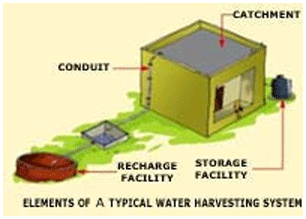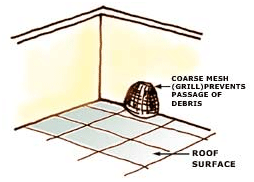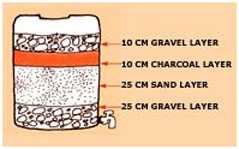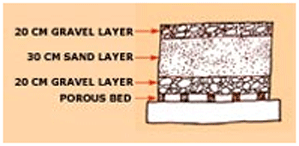Elements of Rain Water Harvesting
A rainwater harvesting system comprises components of various stages – transporting rainwater through pipes or drains, filtration, and storage in tanks for reuse o r recharge. The common components of a rainwater harvesting system involved in these stages are illustrated here.
1.Catchment
The catchment of a water harvesting system is the surface which directly receives the rainfall and provides water to the system. It can be a paved area like a terrace or courtyard of a building, or an unpaved area like a lawn or open ground. A roof made of reinforced cement concrete (RCC), galvanised iron or corrugated sheets can also be used for water harvesting.
2. Coarse mesh at the roof to prevent the passage of debris
3. Gutters
Channels all around the edge of a sloping roof to collect and transport rainwater to the storage tank. Gutters can be semi-circular or rectangular and could be made using:
- Locally available material such as plain galvanised iron sheet (20 to 22 gauge), folded to required shapes.
- Semi-circular gutters of PVC material can be readily prepared by cutting those pipes into two equal semi-circular channels.
- Bamboo or betel trunks cut vertically in half.
The size of the gutter should be according to the flow during the highest intensity rain. It is advisable to make them 10 to 15 per cent oversize.
Gutters need to be supported so they do not sag or fall off when loaded with water. The way in which gutters are fixed depends on the construction of the house; it is possible to fix iron or timber brackets into the walls, but for houses having wider eaves, some method of attachment to the rafters is necessary.
4. Conduits
Conduits are pipelines or drains that carry rainwater from the catchment or rooftop area to the harvesting system. Conduits can be of any material like polyvinyl chloride (PVC) or galvanized iron (GI), materials that are commonly available.
The following table gives an idea about the diameter of pipe required for draining out rainwater based on rainfall intensity and roof area:
Sizing of rainwater pipe for roof drainage
| Diameter Of pipe (mm) | Average rate of rainfall in mm/h | |||||
| 50 | 75 | 100 | 125 | 150 | 200 | |
| 50 | 13.4 | 8.9 | 6.6 | 5.3 | 4.4 | 3.3 |
| 65 | 24.1 | 16.0 | 12.0 | 9.6 | 8.0 | 6.0 |
| 75 | 40.8 | 27.0 | 20.4 | 16.3 | 13.6 | 10.2 |
| 100 | 85.4 | 57.0 | 42.7 | 34.2 | 28.5 | 21.3 |
| 125 | – | – | 80.5 | 64.3 | 53.5 | 40.0 |
| 150 | – | – | – | – | 83.6 | 62.7 |
5. First-flushing
A first flush device is a valve that ensures that runoff from the first spell of rain is flushed out and does not enter the system. This needs to be done since the first spell of rain carries a relatively larger amount of pollutants from the air and catchment surface.
6. Filter
The filter is used to remove suspended pollutants from rainwater collected over roof. A filter unit is a chamber filled with filtering media such as fibre, coarse sand and gravel layers to remove debris and dirt from water before it enters the storage tank or recharge structure. Charcoal can be added for additional filtration.
(i) Charcoal water filter
A simple charcoal filter can be made in a drum or an earthen pot. The filter is made of gravel, sand and charcoal, all of which are easily available.
(ii) Sand filters
Sand filters have commonly available sand as filter media. Sand filters are easy and inexpensive to construct. These filters can be employed for treatment of water to effectively remove turbidity (suspended particles like silt and clay), colour and microorganisms.
In a simple sand filter that can be constructed domestically, the top layer comprises coarse sand followed by a 5-10 mm layer of gravel followed by another 5-25 cm layer of gravel and boulders.
(ii. a) Dewas filters
Most residents in Dewas, Madhya Pradesh, have wells in their houses. Formerly, all that those wells would do was extract groundwater. But then, the district administration of Dewas initiated a groundwater recharge scheme. The rooftop water was collected and allowed to pass through a filter system called the Dewas fillter, designed by Mohan Rao , district collecter of Dewas, and engineers of the rural engineering services. The water thus filtered is put into the service tubewell.
The filter consists of a polyvinyl chloride (PVC) pipe 140 mm in diameter and 1.2m long. There are three chambers. The first purification chamber has pebbles varying between 2-6 mm, the second chamber has slightly larger pebbles, between 6 and 12 mm and the third chamber has the largest – 12-20 mm pebbles. There is a mesh at the outflow side through which clean water flows out after passing through the three chambers. The cost of this filter unit is Rs 600.
 Having any query regarding Rainwater Harvesting? Let our Expert help you. Click here. Having any query regarding Rainwater Harvesting? Let our Expert help you. Click here. |
Filter for large rooftops
When rainwater is harvested in a large rooftop area, the filtering system should accommodate the excess flow. A system is designed with three concentric circular chambers in which the outer chamber is filled with sand, the middle one with coarse aggregate and the inner-most layer with pebbles.
(ii. b.) Horizontal roughing filter and slow sand filter
The introducton of horizontal roughing filter and slow sand filter (HRF/SSF) to treat surface water has made safe drinking water available in coastal pockets of Orissa. The major components of this filter are described below.
1) Filter channel : One square metre in cross-section and eight m in length, laid across the tank embankment, the filter channel consists of three uniform compartments, the first packed with broken bricks, the second with coarse sand, followed by fine sand in the third compartment. The HRF usually consists of filter material like gravel and coarse sand that successively decreases in size from 25 mm to 4 mm. The bulk of solids in the incoming water is separated by this coarse filter media or HRF. At every outlet and inlet point of the channel, fine graded mesh is implanted to prevent entry of finer materials into the sump. The length of a channel varies according to the nature of the site selected for the sump.
2) Sump: A storage provision to collect filtered water from the tank through the filter channel for storage and collection.
While HRF acts as a physical filter and is applied to retain solid matter, SSF is primarily a biological filter, used to kill microbes in the water. Both filter types are generally stable, making full use of the natural purification process of harvested surface water and do not require any chemicals.
7. Storage facility
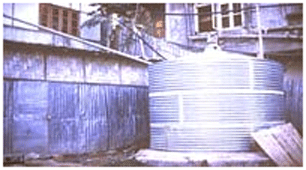
There are various options available for the construction of these tanks with respect to the shape, size and the material of construction.
Shape: Cylindrical, rectangular and square.
Material of construction: Reinforced cement concrete, (RCC), ferrocement, masonry, plastic (polyethylene) or metal (galvanised iron) sheets are commonly used.
Position of tank: Depending on space availability these tanks could be constructed above ground, partly underground or fully underground. Some maintenance measures like cleaning and disinfection are required to ensure the quality of water stored in the container.
8. Recharge structures
Rainwater may be charged into the groundwater aquifers through any suitable structures like dugwells, borewells, recharge trenches and recharge pits.
Various recharge structures are possible – some which promote the percolation of water through soil strata at shallower depth (e.g., recharge trenches, permeable pavements) whereas others conduct water to greater depths from where it joins the groundwater (e.g. recharge wells). At many locations, existing structures like wells, pits and tanks can be modified as recharge structures, eliminating the need to construct any structures afresh. Here are a few commonly used recharging methods:
1. Recharging of dugwells and abandoned tubewells.
In alluvial and hard rock areas, there are thousands of wells which have either gone dry or whose water levels have declined considerably. These can be recharged directly with rooftop run-off. Rainwater that is collected on the rooftop of the building is diverted by drainpipes to a settlement or filtration tank, from which it flows into the recharge well (borewell or dugwell).
If a tubewell is used for recharging, then the casing (outer pipe) should preferably be a slotted or perforated pipe so that more surface area is available for the water to percolate. Developing a borewell would increase its recharging capacity (developing is the process where water or air is forced into the well under pressure to loosen the soil strata surrounding the bore to make it more permeable).
If a dugwell is used for recharge, the well lining should have openings (weep-holes) at regular intervals to allow seepage of water through the sides. Dugwells should be covered to prevent mosquito breeding and entry of leaves and debris. The bottom of recharge wells should be desilted annually to maintain the intake capacity.
Providing the following elements in the system can ensure the quality of water entering the recharge wells:
1. Filter mesh at entrance point of rooftop drains
2. Settlement chamber
3. Filter bed
2. Settlement tank
Settlement tanks are used to remove silt and other floating impurities from rainwater. A settlement tank is like an ordinary storage container having provisions for inflow (bringing water from the catchment), outflow (carrying water to the recharge well) and overflow. A settlement tank can have an unpaved bottom surface to allow standing water to percolate into the soil.
In case of excess rainfall, the rate of recharge, especially of borewells, may not match the rate of rainfall. In such situations, the desilting chamber holds the excess amount of water till it is soaked up by the recharge structure. Thus, the settlement chamber acts like a buffer in the system.
Any container, (masonry or concrete underground tanks, old unused tanks, pre-fabricated PVC or ferrocement tanks) with adequate capacity of storage can be used as a settlement tank.
3. Recharging of service tubewells.
In this case the rooftop runoff is not directly led into the service tubewells, to avoid chances of contamination of groundwater. Instead rainwater is collected in a recharge well, which is a temporary storage tank (located near the service tubewell), with a borehole, which is shallower than the water table. This borehole has to be provided with a casing pipe to prevent the caving in of soil, if the strata is loose. A filter chamber comprising of sand, gravel and boulders is provided to arrest the impurities.
4. Recharge pits
A recharge pit is 1.5m to 3m wide and 2m to 3m deep. The excavated pit is lined with a brick/stone wall with openings (weep-holes) at regular intervals. The top area of the pit can be covered with a perforated cover. Design procedure is the same as that of a settlement tank.
5. Soakaways / Percolation pit
Percolation pits, one of the easiest and most effective means of harvesting rainwater, are generally not more than 60 x 60 x 60 cm pits, (designed on the basis of expected runoff as described for settlement tanks), filled with pebbles or brick jelly and river sand, covered with perforated concrete slabs wherever necessary.
6.Recharge trenches
A recharge trench is a continuous trench excavated in the ground and refilled with porous media like pebbles, boulders or broken bricks. A recharge trench can be 0.5 m to 1 m wide and 1 m to 1.5 m deep. The length of the recharge trench is decided as per the amount of runoff expected. The recharge trench should be periodically cleaned of accumulated debris to maintain the intake capacity. In terms of recharge rates, recharge trenches are relatively less effective since the soil strata at depth of about 1.5 metres is generally less permeable. For recharging through recharge trenches, fewer precautions have to be taken to maintain the quality of the rainfall runoff. Runoff from both paved and unpaved catchments can be tapped.
7.Recharge troughs
To collect the runoff from paved or unpaved areas draining out of a compound, recharge troughs are commonly placed at the entrance of a residential/institutional complex.These structures are similar to recharge trenches except for the fact that the excavated portion is not filled with filter materials. In order to facilitate speedy recharge, boreholes are drilled at regular intervals in this trench. In design part, there is no need of incorporating the influence of filter materials.
This structure is capable of harvesting only a limited amount of runoff because of the limitation with regard to size.
8. Modified injection well
In this method water is not pumped into the aquifer but allowed to percolate through a filter bed, which comprises sand and gravel. A modified injection well is generally a borehole, 500 mm diameter, which is drilled to the desired depth depending upon the geological conditions, preferably 2 to 3 m below the water table in the area. Inside this hole a slotted casing pipe of 200 mm diameter is inserted. The annular space between the borehole and the pipe is filled with gravel and developed with a compressor till it gives clear water. To stop the suspended solids from entering the recharge tubewell, a filter mechanism is provided at the top.
